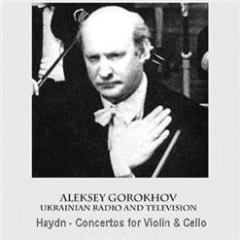Haydn - Concertos For Violin And Cello (1994)
Haydn - Concertos For Violin And Cello (1994)

Violin Concerto No. 1 in C major, Hob.VIIa:1 19:01 1: I. Allegro moderato 9:18 2: II. Adagio 5:17 3: III. Finale 4:26 Cello Concerto No. 1 in C major, Hob. VIIb:1 25:38 4: I. Moderato 9:29 5: II. Adagio 9:24 6: III. Allegro molto 6:45 Cello Concerto No. 2 in D Major, Hob. VIIb 25:22 7: I. Allegro moderato 15:25 8: II. Adagio 5:34 9: III. Rondo 4:23 Aleksey Gorokhov - violin Leonid Gorokhow - cello Ukrainian Radio and Television Orchestra Theodore Kuchar - conductor
The delightful C major Violin Concerto, like various other Haydn's concerti only relatively recently rediscovered, was composed for the well-known Italian violinist Luigi Tommasini. The exact date of composition is unknown -- it has been ascribed to the year 1769, but only because it appears in a publisher's catalog for that year. No matter when it was composed, it is certainly one of the most attractive concerti (of Haydn's or otherwise) from the middle of the eighteenth century.
The opening movement is energetic and regal, as one would expect from its C major tonality, with virtuoso writing more in the Italian tradition than the northern one -- the solo part has wide melodic leaps, long strings of harmonic sequences, and frequent arpeggiation. The slow movement has become somewhat famous on its own, and rightly so. It is cast in three sections, and the opening and closing sections are built on a simple rising idea in the violin part, supported by a repetitive accompaniment which crescendos to a climax along with the soloist. The central section is sweetly lyrical, with the strings providing gentle support for the violinist's musings. There is an opportunity for the soloist to insert a brief cadenza shortly before the close of the movement. The finale, a lively romp in 3/8 time, is technically quite difficult (and would have been exceedingly troublesome for violinists of the day). ---Blair Johnston, allmusic.com
The Cello Concerto in C major, Hob VIIb:1, dates from the first half of the 1760s, and was almost certainly written for the first cellist of the Esterházy orchestra at that time, Joseph Weigl. Weigl seems to have been a particularly good friend of Haydn’s; his son—later to become a successful composer himself—was Haydn’s godson. One can get an idea of Weigl Snr’s cellistic specialities, not only from this concerto, and from the aria for solo cello that forms the slow movement of Haydn’s contemporaneous symphony No 13, but also from the concertos of Leopold Hoffmann that were (presumably) written for Weigl after he left Esterházy and joined Hoffmann’s orchestra in Vienna. Weigl seems to have been fond of holding long notes, growing in volume throughout (as demonstrated by the cello entries of both the second and third movements of Haydn’s C major concerto), and of brilliant passagework in the thumb position—at that point a fairly new addition to the arsenal of cello technique.
The Cello Concerto in D major, Hob VIIb:2 (Op 101), was written many years later, in 1783. (Haydn actually writes ‘783’ on the manuscript—what’s a thousand years between friends?) By now the first cellist in Esterházy was Herr Kraft, who aside from being a virtuoso cellist, and despite not having written this particular concerto, was no mean composer himself, having studied composition with Haydn. He was renowned for his singing tone—and his skill in playing at the very top of the instrument. Again, it is not only this concerto that offers us evidence of these specialities; it is also Kraft’s own concertos, and the cello part of Beethoven’s triple concerto, which was very probably written for him. Another little Kraft ‘signature’ appears over the first movement’s second theme, in the form of the only fingering indication in either concerto, ‘sul corda g’ (ie, play on the G string). Keeping a phrase on one string is a good way of unifying the tone-colour. This seems to have been something about which Kraft felt strongly: there is an eyewitness account of him urging Beethoven to put a similar marking into the cello part of his Op 1 No 3 piano trio.
These, however, are not the only distinctions between the two concertos; there is also a notable contrast in style. The C major concerto is defiantly instrumental in nature, the melodies subordinate to the vibrancy of the rhythms, the satisfying architecture of the forms, the swift brilliance of the passagework. The D major concerto is far more operatic, looser in structure, full of catchy tunes and vocal flourishes. This makes sense: 1783 was the year of Haydn’s last opera, Armida. It was also the year in which a son, Antonio, was born to Haydn’s lover, the soprano Luigia Polzelli; rumour, Luigia and Antonio himself all believed Haydn to be the father. So perhaps it is not surprising that singing would have been much on Haydn’s mind at the time.
What the concertos have in common, though, is the sheer joy of creation, as well as the freshness and originality that are hallmarks of Haydn’s greatest work. Perhaps Saint-Saëns, in describing the whole of Haydn’s output, put it best: ‘No musician was ever more prolific or showed a greater wealth of imagination. When we examine this mine of jewels we are astonished to find at every step a gem which we would have attributed to the invention of some modern or other.’ ---Steven Isserlis, hyperion-records.co.uk
download (mp3 @320 kbs):








